
According to a report released by the Monitoring and Evaluation Wing of the Directorate of Secondary and Higher Education (DSHE), only 12% of the multimedia classrooms across the whole country are being used regularly
The government has been trying to create a digital classroom system as part of their plan to implement e-learning for several years, according to Education Ministry sources.
If the plan to create an effective digital classroom in every educational institute is successful, it would be possible to implement the e-learning educational system with the Access to Information (a2i) Program from the Prime Minister’s Office. However, the multimedia classroom arrangements have not yet shown any significant progress in the last nine years.
Slow internet speeds, power cuts, the inability of some teachers to use technology, and many other problems are making it impossible to create an effective digital classroom system.
The project to start one multimedia classroom in every secondary and higher secondary level institute was undertaken in 2011. Under this project, a computer lab and multimedia classroom was created in 20,500 schools, colleges, and madrasas. Each of these institutes was given a laptop, internet modem, multimedia projector, screen and sound system.
According to a report released by the Monitoring and Evaluation Wing of the Directorate of Secondary and Higher Education (DSHE), only 12% of the multimedia classrooms across the whole country are being used regularly.
The government undertook the ICT Phase 2 Project, to start 31,340 digital classrooms across the country in 2016 and it was implemented in 2017. Only a few internet modems were sent to several institutes. Laptops and projectors have not even been bought yet, but the project will expire in June this year.
In the wake of the coronavirus pandemic, the government decided on the closure of educational institutions till April 9. The closure may be extended.
Considering the situation, state-run Sangsad Bangladesh Television started broadcasting lessons for students of class VI to class IX from Sunday, so that students do not fall behind in their academic activities.
Similarly, multimedia classrooms were built in 1,500 primary schools in 2016 to kickstart e-learning in the primary education phase.
On February 14 of the same year, Prime Minister Sheikh Hasina inaugurated digital content prepared for primary level students under the program, “Transforming Primary Education Content into Interactive Multimedia Digital Versions.”
This program covered 17 books for first to fifth graders, including Bangla, English, Mathematics, Science, and Bangladesh and Global Studies, based on the syllabus provided by the National Curriculum and Textbook Board (NCTB).
Brac provided technical assistance in making the digital versions for 12 Bangla, Mathematics, Science, and Bangladesh and Global Studies books, while the content of five English books was digitized with help from Save the Children.
Despite all these efforts, the program has not shown any significant results as teachers are either not skilled in the system or not willing enough, and the internet is very slow.
With the help of the a2i project, e-classes will be started at 509 primary schools within June this year, according to the Ministry of Primary and Mass Education.
In light of the coronavirus pandemic, video classes are being recorded for primary schools across the country. The Directorate of Primary Education has already shortlisted teachers for shooting the videos.
The videos will be sent to all the primary schools and the head teacher will then send them to the students. The students will be able to learn from home.
Parents were requested to extend their support to make this effort successful.
If the holidays are not extended, students can take online lessons with the video classes.









